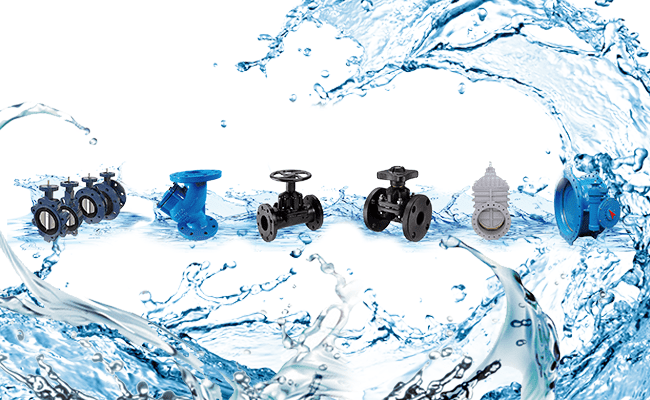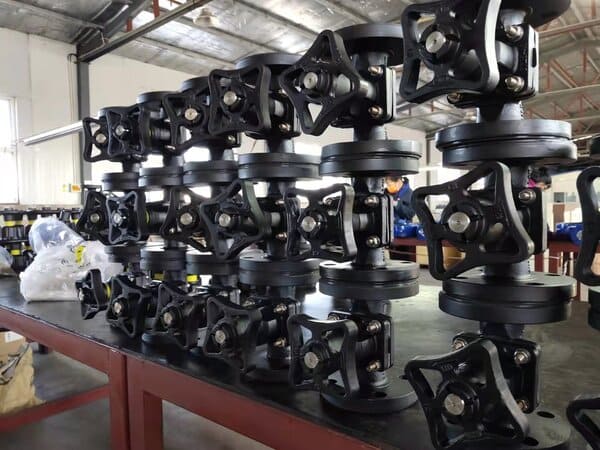The structure of the diaphragm valve is very different from the general valve. It relies on a soft rubber film or plastic film to control the fluid movement. Common diaphragm valve materials are divided into ductile iron,cast irons, cast steel , stainless steel, and plastic .
The working principle of the diaphragm valve
There is a diaphragm between the valve body and the valve bonnet of the diaphragm valve. The diaphragm is made of rubber or polytetrafluoroethylene. When the diaphragm moves up and down, it adjusts the flow through the valve and achieves the purpose of adjustment: when the diaphragm covers the weir surface of the valve body, the flow is cut off and the valves is closed.
Advantages of diaphragm valve
①Simple structure, few parts, the diaphragm valve is composed of three main single parts: the valve body, the diaphragm and the bonnet assembly.
②It is convenient to disassemble and repair. Generally, the damaged part of the diaphragm valve is the diaphragm. When replacing the diaphragm, you do not need to remove the valve from the pipeline, just remove the valve bonnet. The replacement of the diaphragm can be completed in a short time on site.
③Good sealing performance. Because the diaphragm is made of soft materials such as rubber or plastic, it has better sealing performance, but the mechanical life of the diaphragm is shorter. The medium in the valve will not leak from the connection between the valve body and the valve bonnet. The upstream and downstream of the valve can be completely cut off without internal leakage.
④There is no corner in the valve. The flow path of the valve body is streamlined, the flow path is smooth, and there is no corner. The medium flowing through the valve cannot be deposited in the valve to become moldy and deteriorate, and it is easy to wash. The flowing medium will not get stuck when it contains fibers or particles. die.
⑤Diaphragm valve is without packing structure, so does not need packing, and is non-corrosive to the valve stem and bonnet (because the diaphragm separates the lower valve body from the inner cavity of the upper bonnet).
⑥ It can be used for cutting off and throttling.
⑦ Due to the diversity of the lining, it can ensure good chemical resistance.
⑧Suitable for various working conditions. Diaphragm valve is especially suitable for dangerous chemicals and radioactive fluids. Because the valve does not make pollution, it is widely used in product processing, pharmacy, food, nuclear industry and other industries that do not allow pollution.
Varieties of diaphragm valves
There are British standard diaphragm valve, rubber-lined diaphragm valve/fluorine-lined diaphragm valve, direct-flow rubber-lined diaphragm valve, British standard pneumatic diaphragm valve, British standard pneumatic rubber-lined diaphragm valve (reciprocating), pneumatic fluorine-lined diaphragm valve, reciprocating pneumatic Diaphragm valves, electric diaphragm valves, vacuum diaphragm valves, internal thread diaphragm valves, sanitary stainless steel diaphragm valves, three-way diaphragm valves, direct-flow rubber-lined globe valves, plastic diaphragm valves.
The development direction of diaphragm valve
At present, there are two major development directions in the production of foreign diaphragm valves.
One is large-scale and high-parameterization, mainly to meet various special requirements and reflect the design and manufacturing level of various countries. If the nominal pressure can reach PN16~40, the maximum pressure level can reach 4.5MPa, the working temperature can reach 65~200°C, and the maximum temperature can reach 300°C. In addition to the water treatment system of 300MW, 600MW and 1500MW large thermal power generating units, the diaphragm valve is also used in 900MW nuclear power plants.
The second is to meet the supporting needs of general industrial pipelines, with a large production volume and a wide range of products (industrial valves) to adapt to a variety of corrosive media, suitable for nearly 400 to 700 types of media. The service life of the rubber diaphragm valve is more than 100,000 times, and the highest can reach 270,000 to 500,000 times. Manufacturers are striving for specialization, automation and standardization from perfecting process manufacturing, saving raw materials and improving production capacity.




